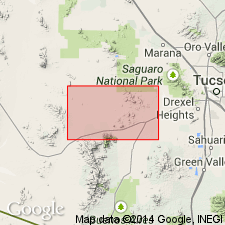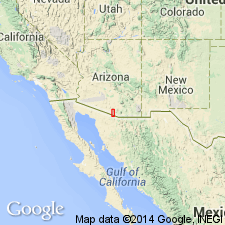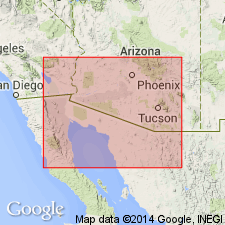
- Usage in publication:
-
- Sil Nakya Formation*
- Modifications:
-
- Named
- Dominant lithology:
-
- Tuff
- Conglomerate
- Mudstone
- Sandstone
- AAPG geologic province:
-
- Basin-and-Range province
Summary:
Named. Type section is generally along a northeast-trending wash that heads 1 1/4 mi east-southeast of the village of Sil Nakya in the Sil Nakya Hills, Pima Co, AZ in the Basin-and-Range province. Includes thick units of welded tuff and thinner units of tuff agglomerate, andesitic or basaltic flows, maroon mudstone and sandstone, and conglomerate. Basal unit is massive gray welded tuff composed of rhyolite, quartz latite, or dacite with some intercalated sedimentary rocks and a few andesitic or basaltic flows. Top unit is a 1,000 ft thick brown, pebble to boulder conglomerate with fragments of welded tuff and agglomerate. At least 8,000 ft thick; at least 6,400 ft is welded. Appears to overlie the newly named Roadside Formation (Mesozoic). Overlain by alluvium, or top is in fault contact with the Sand Wells Formation (newly named). Probably equivalent to Roskruge Rhyolite (newly named). Is Mesozoic. Geologic map.
Source: GNU records (USGS DDS-6; Denver GNULEX).

- Usage in publication:
-
- Sil Nakya Formation*
- Modifications:
-
- Age modified
- AAPG geologic province:
-
- Basin-and-Range province
Summary:
Is considered correlative with Roskruge Volcanics and of Late Cretaceous age.
Source: GNU records (USGS DDS-6; Denver GNULEX).

- Usage in publication:
-
- Sil Nakya Formation*
- Modifications:
-
- Age modified
- AAPG geologic province:
-
- Basin-and-Range province
Summary:
Is approximately same age as Mulberry Wash and Ali Molina Formation of Early Jurassic age. Probably correlative with Ox Frame Volcanics.
Source: GNU records (USGS DDS-6; Denver GNULEX).

- Usage in publication:
-
- Sil Nakya Formation*
- Modifications:
-
- Age modified
- AAPG geologic province:
-
- Basin-and-Range province
Summary:
Age assignment based on placement of Aalenian as the basal stage of the Middle Jurassic between the Lower Jurassic Toarcian Stage and the Middle Jurassic Bajocian Stage. [Some authors follow Imlay (1980) in that they do not recognize the Aalenian Stage and they place the Lower-Middle Jurassic boundary between the Toarcian and the Bajocian.] Known in Pima Co, AZ in Basin-and-Range province.
Source: GNU records (USGS DDS-6; Denver GNULEX).
For more information, please contact Nancy Stamm, Geologic Names Committee Secretary.
Asterisk (*) indicates published by U.S. Geological Survey authors.
"No current usage" (†) implies that a name has been abandoned or has fallen into disuse. Former usage and, if known, replacement name given in parentheses ( ).
Slash (/) indicates name conflicts with nomenclatural guidelines (CSN, 1933; ACSN, 1961, 1970; NACSN, 1983, 2005, 2021). May be explained within brackets ([ ]).

